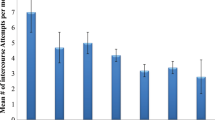Abstract
The objectives of the study were to characterize male sexual functioning as related to age in community-dwelling older men. In 1989, a random sample of men aged 40–79 y (n=2115) without prior prostate surgery, prostate cancer, or other conditions known to affect voiding function (except benign prostatic hyperplasia) was invited (55% agreed) to participate in the Olmsted County Study of Urinary Symptoms and Health Status Among Men. In 1996, a previously validated male sexual function questionnaire was administered to the cohort. The questionnaire has 11 questions measuring sexual drive (two questions); erectile function (three) and ejaculatory function (two), as well as assessing problems with sex drive, erections, or ejaculation (three); and overall satisfaction with sex life (one). Each question is scored on a scale of 0–4, with higher scores indicating better functioning. Cross-sectional age-specific means (±s.d.) for drive, erections, ejaculation, problems, and overall satisfaction declined from 5.2 (±1.5), 9.8 (±2.5), 7.4 (±1.4), 10.7 (±2.2), and 2.6 (±1.0), respectively, for men in their 40s to 2.4 (±1.6), 3.3 (±3.4), 3.6 (±3.2), 7.7 (±3.8), and 2.1 (±1.2) for men 70 y and older (all P<0.001). The cross-sectional decline in function with age was not constant, with age-related patterns differing by domain. The percentage of men reporting erections firm enough to have intercourse in the past 30 days declined from 97% (454/468) among those in their 40s to 51% (180/354) among those in their 80s (P<0.001). In age-adjusted analyses, men reporting regular sexual partners had statistically significantly higher levels of sex drive, erectile function, ejaculatory function, and overall satisfaction than those who did not report regular sexual partners. Sexual drive, erectile functioning, ejaculatory functioning, and overall sexual satisfaction in men show somewhat differing cross-sectional patterns of decline with advancing age. Active sexual functioning is maintained well into the 80s in a substantial minority of community-dwelling men.
This is a preview of subscription content, access via your institution
Access options
Subscribe to this journal
Receive 8 print issues and online access
$259.00 per year
only $32.38 per issue
Buy this article
- Purchase on Springer Link
- Instant access to full article PDF
Prices may be subject to local taxes which are calculated during checkout


Similar content being viewed by others
References
Panser LA et al. Sexual function of men ages 40 to 79 years: The Olmsted County Study of Urinary Symptoms and Health Status Among Men. JAGS 1995; 43: 1107–1111.
Macfarlane GJ et al. The relationship between sexual life and urinary condition in the French community. J Clin Epidemiol 1996; 49: 1171–1176.
Feldman HA et al. Impotence and its medical and psychosocial correlates: results of the Massachusetts Male Aging Study. J Urol 1997; 151: 54–61.
Frankel SJ et al. Sexual dysfunction in men with lower urinary tract symptoms. J Clin Epidemiol 1998; 51: 677–685.
Masumori N et al. Decline of sexual function with age in Japanese men compared with American men–results of two community-based studies. Urology 1999; 54: 335–344.
Laumann EO, Paik A, Rosen RC . Sexual dysfunction in the United States: prevalence and predictors. JAMA 1999; 281: 537–544.
Braun M et al. Epidemiology of erectile dysfunction: results of the ‘Cologne Male Survey’. Int J Impot Res 2000; 12: 305–311.
Parazzini F et al. Frequency and determinants of erectile dysfunction in Italy. Eur Urol 2000; 37: 43–49.
Blanker MH et al. Erectile and ejaculatory dysfunction in a community-based sample of men 50 to 78 years old: prevalence, concern, and relation to sexual activity. Urology 2001; 57: 763–768.
Persson G . Sexuality in a 70-year old urban population. J Psychosom Res 1980; 24: 335–342.
Pfeiffer E, Verwoerdt A, Davis GC . Sexual behavior in aged men and women. Arch Gen Psych 1968; 19: 735–738.
Morley JE . Impotence. Am J Med 1986; 80: 897–905.
Koskimaki J, Hakama M, Huhtala H, Tammela TLJ . Effect of erectile dysfunction on frequency of intercourse: a population based prevalence study in Finland. J Urol 2000; 164: 367–370.
O'Leary MP et al. A brief male sexual function inventory for urology. Urology 1995; 46: 697–706.
Chute CG et al. The prevalence of prostatism: a population-based survey of urinary symptoms. J Urol 1993; 150: 85–89.
Jacobsen SJ et al. Natural history of prostatism: risk factors for acute urinary retention. J Urol 1997; 158: 481–487.
Acknowledgements
Project supported by research grants from the Public Health Service, Grants AR30582 and DK58859 from the National Institutes of Health and Merck Research Labs.
Author information
Authors and Affiliations
Corresponding author
Rights and permissions
About this article
Cite this article
O'Leary, M., Rhodes, T., Girman, C. et al. Distribution of the Brief Male Sexual Inventory in community men. Int J Impot Res 15, 185–191 (2003). https://doi.org/10.1038/sj.ijir.3900996
Published:
Issue Date:
DOI: https://doi.org/10.1038/sj.ijir.3900996
Keywords
This article is cited by
-
Sexual function in long-term male lymphoma survivors after high-dose therapy with autologous stem-cell transplantation
Bone Marrow Transplantation (2020)
-
Current Diagnosis and Management of Erectile Dysfunction
Current Sexual Health Reports (2014)
-
Erectile dysfunction association with physical activity level and physical fitness in men aged 40–75 years
International Journal of Impotence Research (2011)
-
Psychometric Properties of the Spanish Version of the Changes in Sexual Functioning Questionnaire-Short-Form (CSFQ-14) in a Sample of Males with Drug Abuse History
Sexuality and Disability (2010)
-
Smoking and sexual dysfunction in Chinese males: findings from men's health survey
International Journal of Impotence Research (2006)



